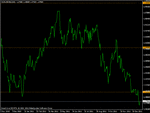you are stretching out the definition. I am sure when you are watching your DOM ladder you are looking for certain 'qualities' or 'tendencies' which give certain characteristic patterns. Therefore you are probably trading 'patterns' too. correct me if I am wrong.
Not really stretching the definition. Anything that repeats itself is a pattern. It doesn't need to be visual.
What I am talking about are not patterns in a traditional sense but a set of circumstance.
Anyway what we are really talking about here imo is whether someone believes that certain market characteristics can and do repeat. I am in the camp which believes that every moment in the market is unique however certain characteristics repeat over and over again and an edge can be derived from this.
This is just the same as watching a DOM ladder and looking for repeating things that happen then watching the market live for these things to happen again.
Whether you class big round numbers with pinbars/outside bars as patterns is really irrelevant. Personally I don't consider them patterns in the traditional sense i.e. trendlines, flags, wedges, indicators etc.
So DT, do you believe that certain market characteristics or patterns do repeat and that it is possible to derive an edge from this? I am guessing you would say no however I am sure you look for patterns in your DOM ladder all day long and this amounts to the same thing.
I think the key here is in the use of objective analysis vs subjective analysis. What you describe above all comes from the world of objective/rules based/mechanical analysis. The world of "if a = x and b = y then go long".
I do use a chart when I trade the ES, I use the tape and DOM too. I use them subjectively though. I use them to get a read on the market and try to make an educated guess on where price will head in the short term. I do not look for a checklist of repeated behaviour on the DOM or the chart. I have rules but they are more like guidelines. If I see a lot of people piling into the market on one day, I have guidelines that tell me how it might behave differently. If it doesn't behave differently, then I'll revert back to how I usually trade. It's a much easier way to approach the markets.
It is my belief that looking back at charts, finding a set of 'rules' to apply to the future is a fools errand. The number of potential rules is infinite. The search could therefore also be infinite. Finding something that 'worked' last year or last 10 years does not guarantee it will not fail immediately when you trade it live. Patterns will appear in totally random data.
On the other hand, if you don't look for that. If you tell yourself it's all shades of grey, then success relies on you becoming better on interpreting the action and NOT on finding a magic combination of factors that can be applied mechanically forever. Instead of a search for a magic bullet, you have a skill that you can develop over time. Huge difference.
The mechanical/objective route to trading is where people look for a solution. The reason of course being that applying a mechanical solution would be a very easy way to trade. On the other hand FINDING that solution is where people (e.g. Travis) spend literally years with no joy.
If people realised how futile this search was and actually embraced subjective analysis (remember Socrates?), then they would find that trading is not rocket science after all.




